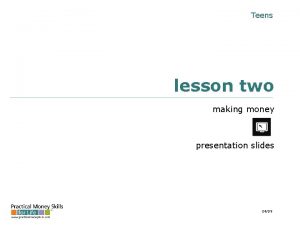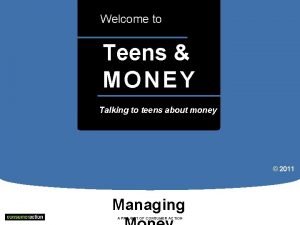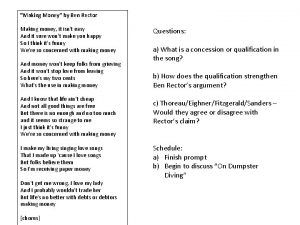Teens lesson two making money 0308 the career









- Slides: 9

Teens lesson two: making money 03/08

the career planning process Whether you are seeking your first job, or considering changing to a different field, you must take various actions to obtain a job. phase 1: 2: 3: 4: Assess your personal interest, abilities, and career goals. Evaluate the current employment market. Identify specific job opportunities. Apply for employment positions with the use of a résumé or application letter. phase 5: Interview for available positions. phase 6: Obtain additional career training. teens – lesson 2 - slide 2 -A

preparing for a job interview before the interview 1. Research the organization. 2. Practice your interviewing skills. 3. Prepare questions that you plan to ask. 4. Prepare proper dress and grooming. 5. Plan to arrive early at the interview. during the interview 1. Relax. Be yourself. 2. Answer questions completely and calmly. 3. Ask questions to help you better know the organization. 4. Ask when you might hear from the organization. after the interview 1. Write down notes on how you can improve for your next interview. 2. Promptly send a thank-you letter to the person with whom you interviewed to express your appreciation for the opportunity to meet with them. teens – lesson 2 - slide 2 -B

common interview questions 1. What activities have helped you expand your interests, abilities, and knowledge? 2. In what types of situations have you done your best work? 3. Describe the supervisors who motivated you the most. 4. Describe someone with whom you had difficulty working. 5. What are your major strengths? 6. What are your weaknesses? What have you done to overcome your weaknesses? 7. What do you know about our organization? 8. Who is someone you admire? Why do you admire that person? teens – lesson 2 - slide 2 -C

adding up the benefits Benefits cost your employer, on average, an extra 33% – 50% of your pay. These may include: • Health, dental, and eye care insurance • • Parental leave • Life insurance/disability insurance • Stock purchase plan • Flexible spending account • Employee assistance plans • Health savings account • Employee fitness programs • Tax-deferred retirement plan • Employee discounts • Paid vacation • Tuition assistance or reimbursement Paid holidays teens – lesson 2 - slide 2 -D

reading a pay stub teens – lesson 2 - slide 2 -E

examples of paycheck deductions Federal Income Tax is a progressive tax. A progressive tax is a type of tax where the effective tax rate (the tax amount expressed as a percentage) increases as the amount to which the rate is applied (a person’s adjusted income) increases. Every year, the U. S. Federal Government changes the tax rates and income brackets. See the chart below for an example from 2008. Year 2008 Federal income brackets and tax rates Marginal Tax Rate Single Married Filing Jointly or Qualified Widow(er) Married Filing Separately Head of Household 10% $0 – $8, 025 $0 – $16, 050 $0 – $8, 025 $0 – $11, 450 15% $8, 026 – $32, 550 $16, 051 – $65, 100 $8, 026 – $32, 550 $11, 451 – $43, 650 25% $32, 551 – $78, 850 $65, 101 – $131, 450 $32, 551 – $65, 725 $43, 651 – $112, 650 28% $78, 851 – $164, 550 $131, 451 – $200, 300 $65, 726 – $100, 150 $112, 651 – $182, 400 33% $164, 551 – $357, 700 $200, 301 – $357, 700 $100, 151 – $178, 850 $182, 401 – $357, 700 35% $357, 701+ $178, 851+ $357, 701+ teens – lesson 2 - slide 2 -F

examples of paycheck deductions (continued) Federal Insurance Compensation Act (FICA), the official name for Social Security and Medicare taxes. The Social Security tax rate is 6. 2% on your gross income, but the amount is limited and you stop paying the tax after you reach a certain income. This limit, known as the Social Security Wage Base, changes each year as economic conditions change. Currently, the Medicare tax rate is 1. 45% on all wages earned with no limit. Your employer must also pay a separate 6. 2% Social Security tax on your behalf and the 1. 45% Medicare tax. State and local income taxes The tax rate ranges from 0% to close to 10% depending on the state and town in which you live. teens – lesson 2 - slide 2 -G

examples of paycheck deductions (continued) Tax-free and tax-deferred benefits The U. S. federal government provides numerous plans that allow an employee to save for certain life events with pre-tax dollars. These savings plans allow a person to invents in their retirement, health care, childcare, and many other life events and receive a tax reduction or pay no tax at all on the money saved. Health Savings Accounts (HSAs), Flexible Spending Accounts (FSAs), 401(k) retirement plans, and many other “cafeteria plans” are examples of tax-advantaged benefits. When you sign up for one of these plans, your savings contribution is automatically deducted from your paycheck before your taxes are calculated, which allows you substantial tax savings and will show up as a line item on your pay stub reflecting an adjustment to your taxable income. Net pay Your net pay—often called your “take home pay”—is the remaining amount you get to keep after all deductions are removed from your gross (or total) pay. teens – lesson 2 - slide 2 -G

















